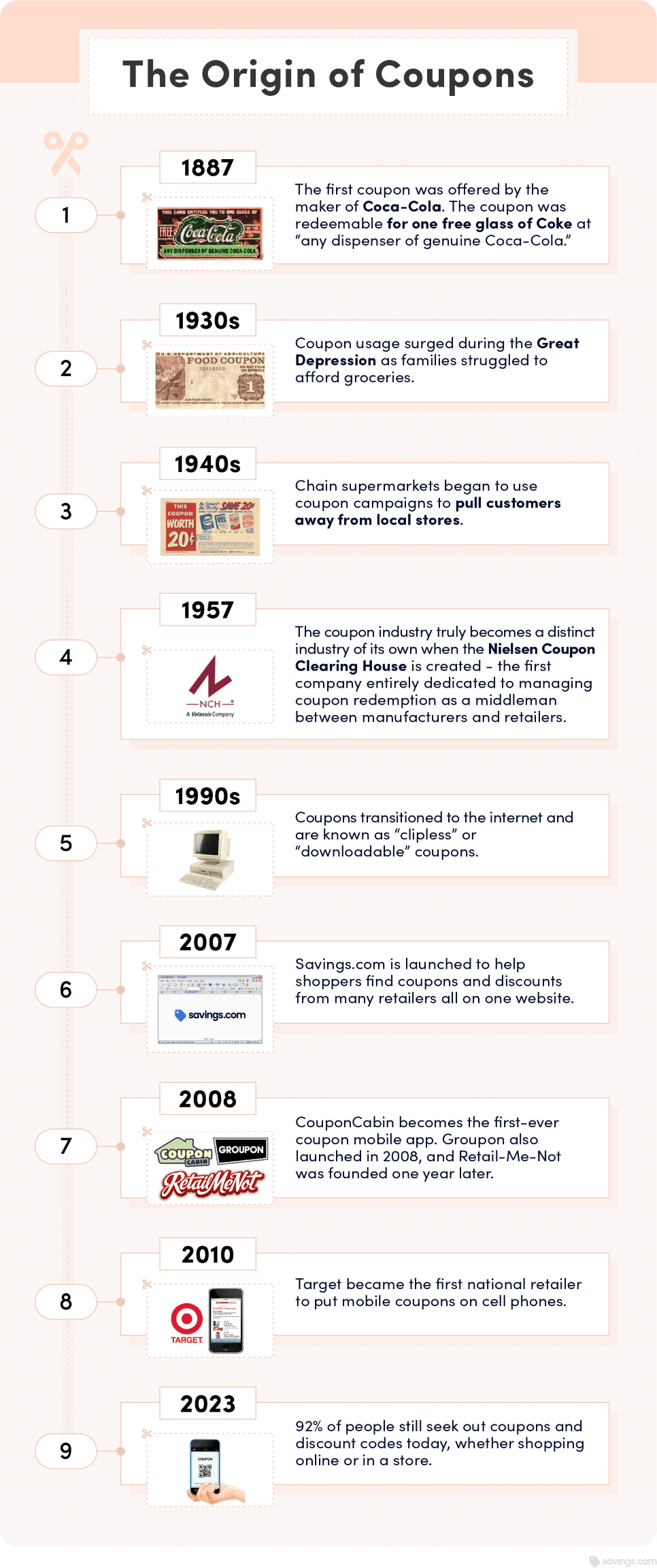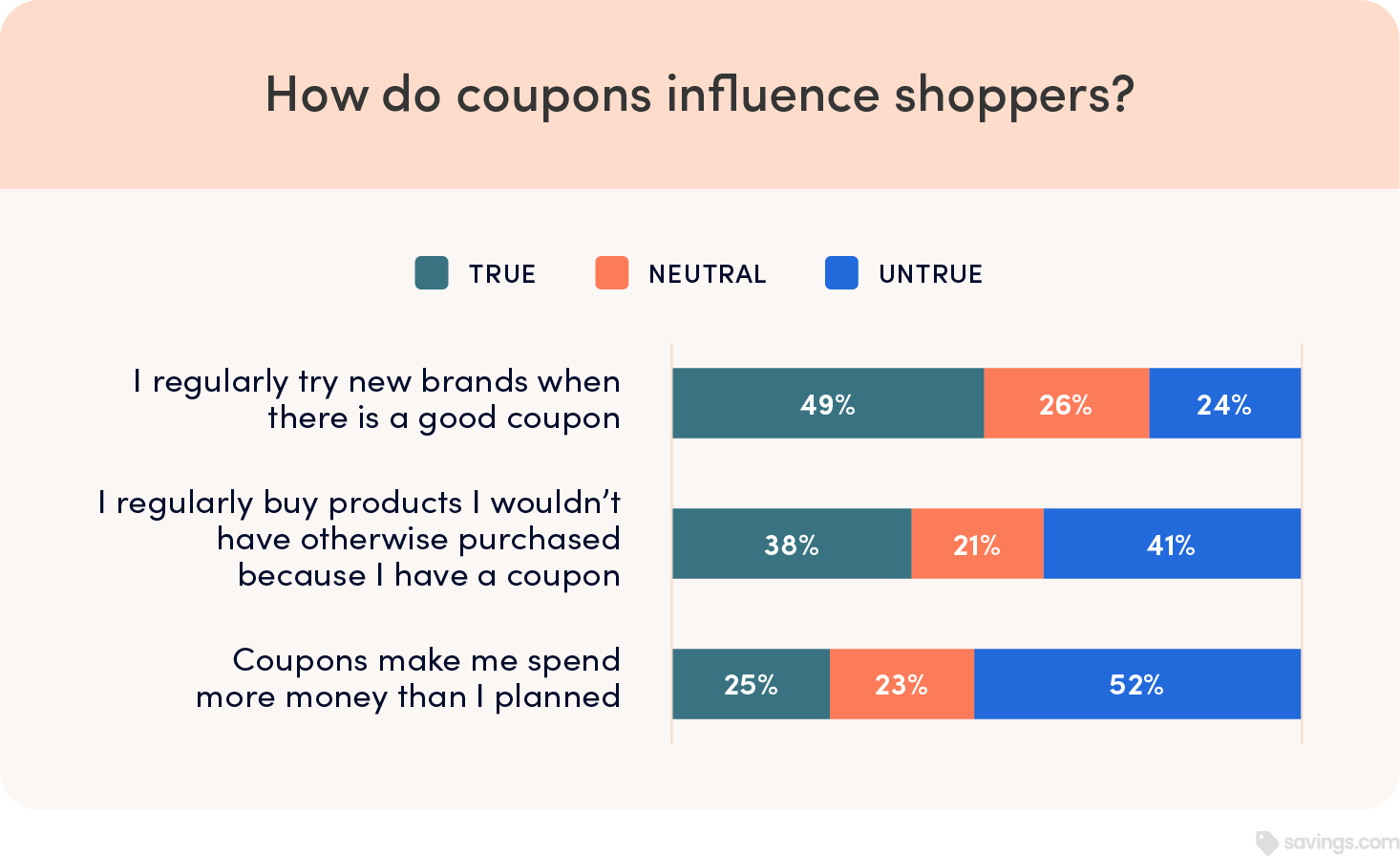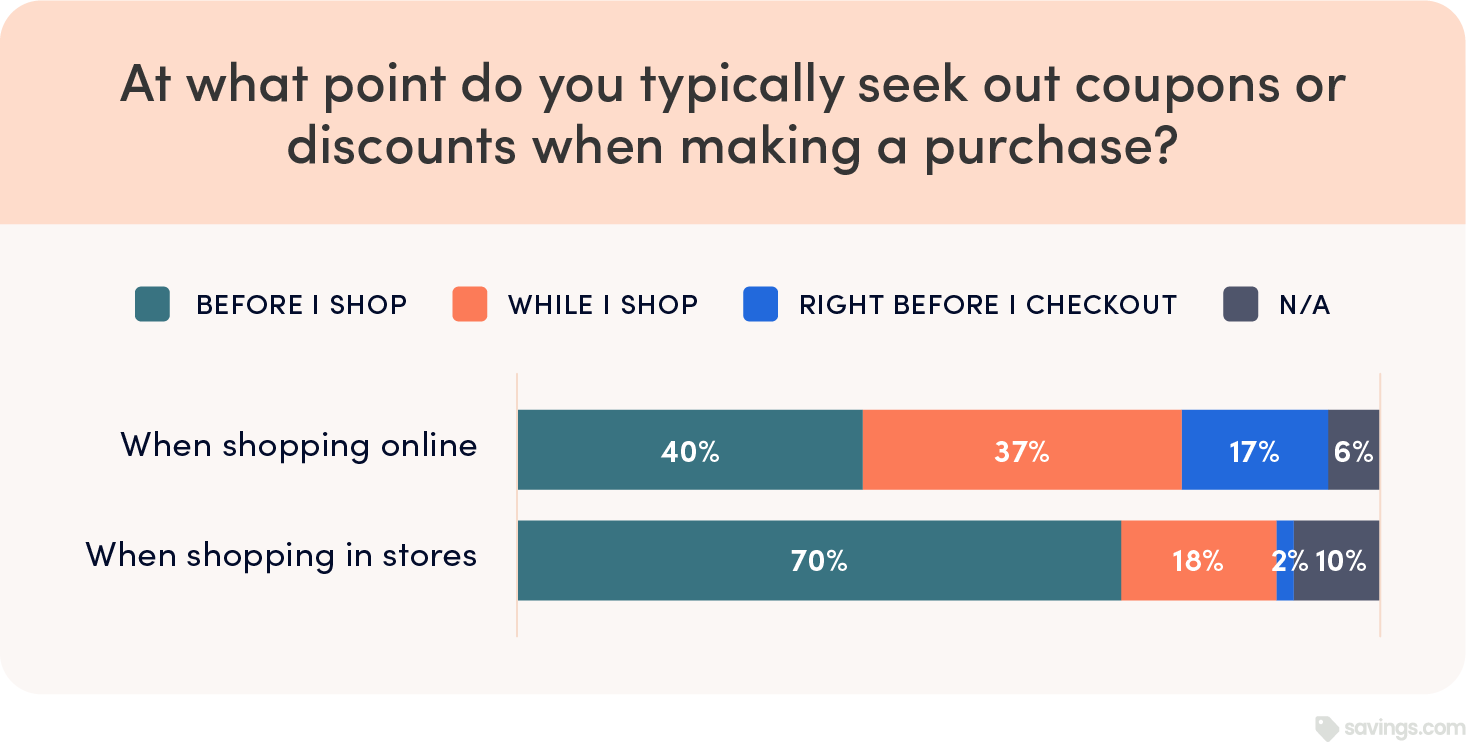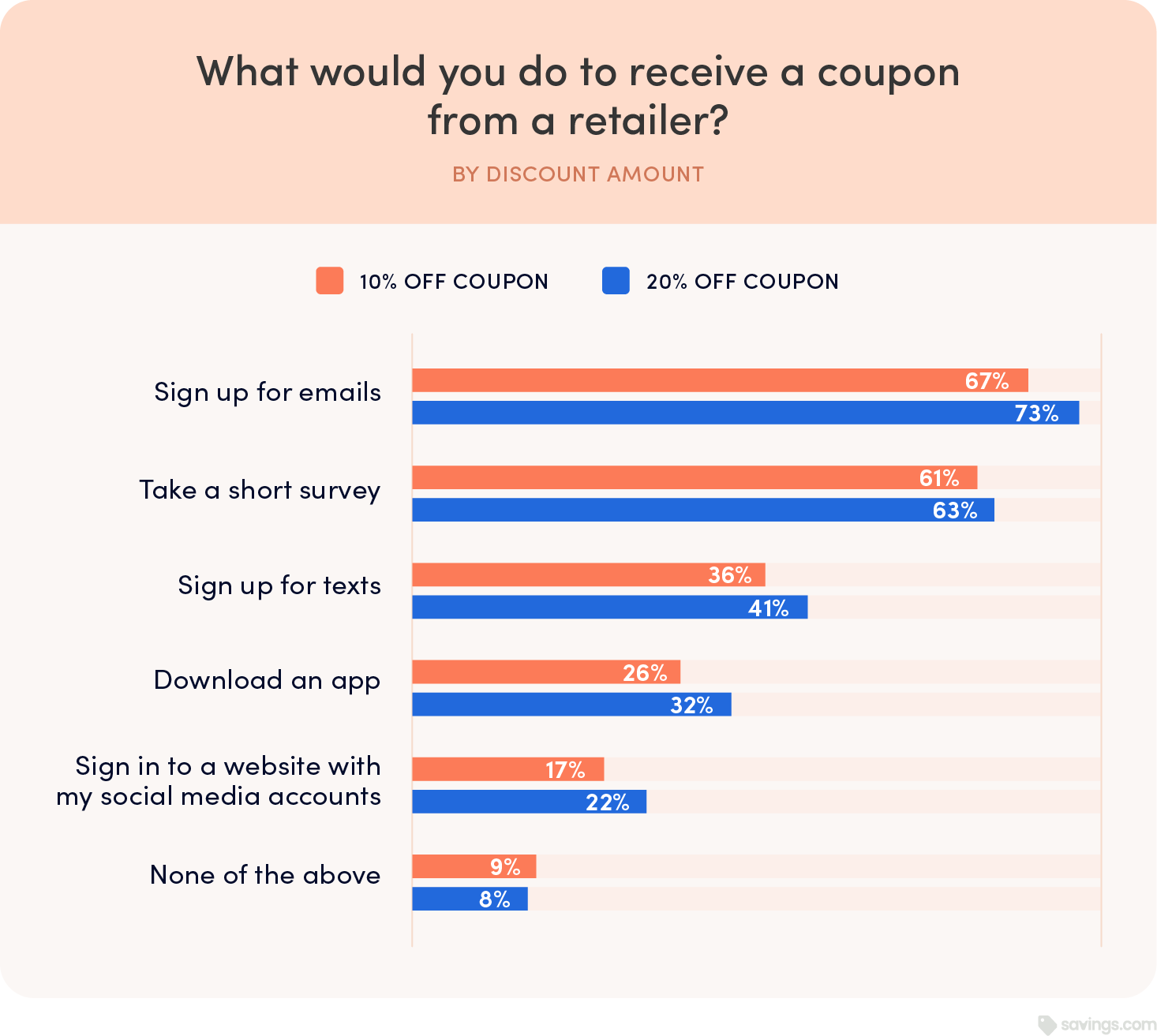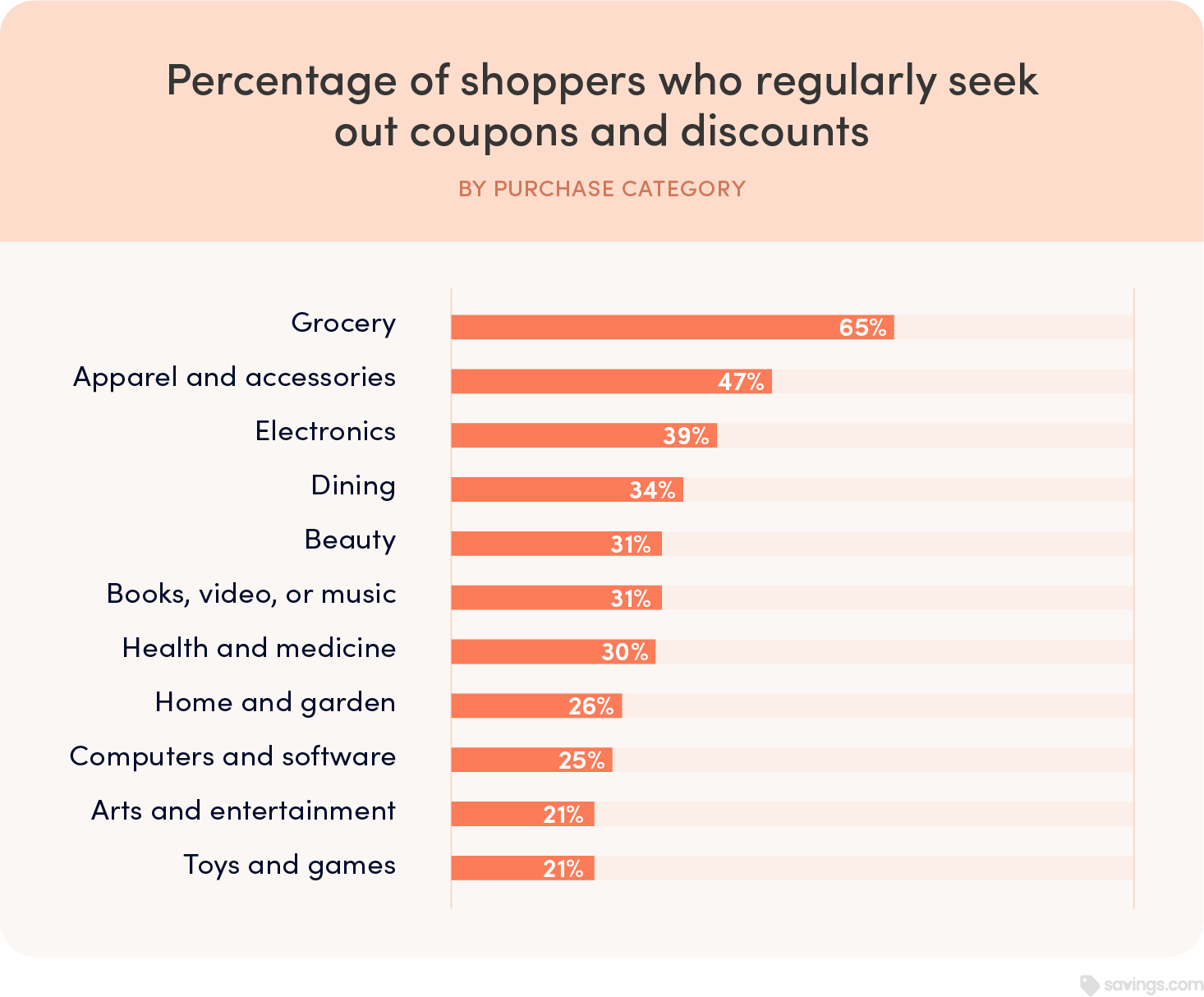
Last Updated: June 5, 2023
Exploring the evolution of coupons and discounts and their impact of consumer behavior and choices
In an era marked by the explosive growth of e-commerce, coupons and discounts have become more important than ever in shaping how consumers choose brands and products. As traditional stores face tough competition from online retailers, coupons and discounts have taken center stage, adapting to meet the changing needs of savvy digital shoppers.
To understand how discounts fit into larger retail trends today, we asked hundreds of U.S. shoppers about their use of coupons and discount codes, both in-store and online. In this article, we’ll explore the insights from our latest consumer study, unraveling the profound impact deals and discounts have on shopper behavior and decision-making.
Here are some of our key findings:
- 92% of people regularly seek out coupons and discount codes, whether shopping online or in a store.
- 82% of shoppers said they still use physical coupons at least occasionally and 85 percent of shoppers said they’d used coupons and discounts found on mobile apps.
- About half of shoppers say they will try new brands if they have a good discount or coupon, and 38 percent said coupons often lead them to buy products they otherwise wouldn’t have.
- Not all deals are the same: customers prefer percentage- and dollar-off discounts over free shipping or rebate after purchase offers.
- Nearly two in three people seek out discounts for groceries and nearly one in two like to look for clothing coupons, making these the most sought after categories for deals.
A brief history of coupons
Before diving into the state of the modern coupon industry, let’s begin with a brief history lesson: modern coupons have been around for over 130 years. The first coupon was issued in 1887 by Coca-Cola. It was a hand-written voucher entitling the bearer to a free glass of Coca-Cola. The coupon was a success and helped make the drink one of the most popular in the country today.
As technology grew, starting with the introduction of barcodes around the 1960s, coupon usage became more widespread. Furthermore, the digital revolution in the late 20th century brought about a shift towards online couponing, with the emergence of coupon websites and mobile apps. Today, coupons have evolved to encompass both traditional paper coupons and digital discounts, catering to the diverse preferences of consumers in the ever-changing retail landscape.
How Coupons Influence Shopping Behavior
Our research revealed that coupons and discounts can have powerful influence on consumers’ choices. They encourage consumers to step out of their comfort zones and try new brands or products that they might not have considered otherwise. Discounts can also fuel impulse buying, making shoppers excited and more likely to make unplanned purchases. Additionally, to access discounts, customers are willing to share personal data, giving brands more power to personalize their marketing efforts and build trust with their customers.
Coupons drive consumers toward new brands
While coupons don’t necessarily make shoppers spend more money, they may encourage them to break away from time-tested brands: Just under half of the people (49 percent) in our study said having a good coupon or discount makes them more likely to try a new brand. Another 38 percent said they use coupons to buy products they otherwise wouldn’t have. In other words, coupons can lead to impulse buys, increasing the average order value for the seller. For example, if consumers need to achieve a minimum order threshold to earn free shipping, they may be swayed to spend more in order to save a few dollars on shipping costs.
Consumers are moved by immediate discounts
Shoppers prioritize instant gratification when it comes to coupons and discounts, with a clear preference for certain types. Here is how shoppers ranked different deals in order of preference:
- Percentage off discount
- Dollar off discount
- Free shipping
- Buy one, get one (BOGO) offers
- Gift card with purchase
- Rebate after purchase
Percentage or dollar-off discounts were most favored by shoppers, which indicates that consumers are motivated by immediate savings, as these discounts directly reduce the total amount they have to pay at the time of purchase. Similarly, the popularity of free shipping deals suggests that shoppers value convenience and avoiding additional costs. It's worth noting that buy one, get one (BOGO) offers are also well-received, as they provide an opportunity for customers to get more value or try new products without incurring extra expenses.
On the other hand, gift cards and rebate offers are less desirable, indicating that customers prefer immediate reductions in their cart totals rather than receiving money back after the transaction. Furthermore, when it comes to receiving discount codes, shoppers overwhelmingly prefer email over text messages.
Consumers like to search for discounts while shopping
Shoppers like to be prepared when they use coupons in stores, so 70 percent look for them before they go. But when they shop online, they're more likely to look for discounts while browsing or checking out. 54 percent of online shoppers do this, compared to just 20 percent of in-store shoppers.
Compared to in-store shopping, it’s easier to browse for deals in real-time when shopping online. This practice would enable customers to take advantage of any last-minute deals or promotions that they may not have been aware of beforehand. This can lead to unexpected savings and a sense of maximizing value during the shopping experience.
Interestingly, women and younger adults are much more likely than men and older adults to look for coupons right before they checkout online.
Consumers are willing to trade personal data for deals
Our findings shed light on the extent to which shoppers value discounts and are willing to trade their personal data for a good deal. When we presented shoppers with the scenario of receiving a 10 percent or 20 percent discount code from a new store, the response was striking. Even for a relatively modest 10 percent discount, two-thirds of shoppers expressed their willingness to sign up for emails, indicating a desire to stay informed about future deals and promotions.
The numbers jumped even higher when the discount increased to 20 percent, with 73 percent of shoppers indicating their willingness to provide their email address in exchange for the greater savings. Offering discounts for customer data is often a lucrative trade-off for sellers: the more they know and understand about their customers, the more they can tailor their products and marketing to appeal to them.
Overall, 90 percent of shoppers stated they would be open to doing at least one of the items we asked about in exchange for a discount. This suggests that the vast majority of consumers are not only receptive to sharing their data but also willing to engage in various actions, such as completing surveys, following the brand on social media, or providing feedback, to secure valuable discounts.
As Prices Climb, Coupon Usage is Nearly Universal
People love saving money, especially on items they use everyday: 92 percent of people in our study said they regularly seek coupons and discounts online and in-store.
Grocery coupons are the most sought-after, with 65 percent of shoppers saying they regularly look for discounts when buying food. This is understandable, given the recent surge in food prices. The USDA expects food price inflation to slow in 2023 but will still be higher than average. As of February 2023, grocery store prices were more than 10 percent higher than in 2022. Apparel and electronics coupons are also popular categories for savvy shoppers.
Online Shoppers Turn to Apps and Aggregators to Secure Deals
When shopping online, nearly 80 percent of the people we talked to use coupons or discount codes at least some of the time, whether they’re shopping on a store’s website or using its mobile app. One in three said they “often" or “always" shop online with discount codes or coupons. Women were actually more likely than men to do this.
Compared to the use of discounts and coupons overall, no single category takes the lion’s share when it comes to mobile app shopping. Still, 85 percent of shoppers said they’d used coupons or discount codes found on mobile apps at some point. Many major retailers, such as Target, Old Navy, and Best Buy, have their own unique mobile apps where users can both find discounts and make purchases. Other apps are designed for aggregating deals and coupons from multiple retailers, such as RetailMeNot or The Krazy Coupon Lady. Groupon is another well-known app where shoppers can find deals on activities and items.
Still, even shoppers are more likely to seek out coupons and discounts on apps for groceries and apparel than any other category, which likely speaks to the broad availability of these tools.
Percentage of shoppers who regularly seek out coupons and discounts from mobile apps, by category
| Grocery | 48% |
| Apparel & Accessories | 37% |
| Electronics | 27% |
| Dining | 24% |
| Beauty | 23% |
| Books, Music & Video | 22% |
| Health & Medicine | 19% |
| Computers & Software | 15% |
| Toys & Games | 15% |
| Home & Garden | 15% |
Coupon aggregating sites also provide simple ways for shoppers to seek out discounts. They work by collecting coupons and promo codes from different retailers. Then, they organize the coupons by retailer and product category, and shoppers can apply the coupon codes to their carts at checkout.
71 percent of people say they regularly use these tools when shopping online. Honey was the most popular among shoppers in our study, especially among younger adults. Paypal acquired the coupon aggregator in 2019 for about $4 billion, and today it has a mobile app and browser plugin used by millions.
Though Honey was the most popular, many of its competitors were almost as widely used. The wide variety of options in the coupon aggregator market reveals high demand for savings among shoppers.
Top five coupon aggregator sites online shoppers regularly use
| Honey | 29% |
| RetailMeNot | 28% |
| Rakuten | 21% |
| Coupons.com | 21% |
| Swagbucks | 20% |
The use of browser extensions for applying discount codes while shopping lags behind the use of discount sites overall, but just over half of shoppers (51 percent) said they use a browser extension like Honey to help them find the best deals.
Physical Coupons are Still Just as Popular as Digital Discounts
It’s easy to think that physical coupons have become a thing of the past, given the widespread use of online coupons. But, 82 percent of shoppers said they still use physical coupons occasionally.
However, while they may be willing to spend some time hunting online for discount codes, they’re much less inclined to spend their time clipping physical coupons. Mailers are the most common way people score physical coupons, with 57 percent of people saying they get their coupons this way. Only 25 percent say they still clip out newspaper coupons.
When you use physical coupons in stores, which type of coupons do you use?
| Mailer coupons | 57% |
| Coupons printed on a receipt | 47% |
| Print-at-home coupons | 29% |
| Newspaper coupons | 25% |
| Other | 6% |
| I don’t use physical coupons | 18% |
Among the shoppers we talked to, physical coupon usage remains just as popular as online deals (82 percent vs. 79 percent). Though it may seem outdated to send out paper coupons in our digital age, local retailers and chains with physical locations should pay attention to these valuable sales tools. They can increase foot traffic, encourage customers to make repeat or complementary purchases, and can create a sense of urgency especially if they have expiration dates.
Conclusion
Coupons and discounts are nearly-universal for American shoppers and have a significant impact on how theymake purchase decisions. They influence brand exploration, spur impulse purchases, and foster a beneficial relationship between shoppers and businesses. Consumers prefer discounts that provide immediate savings, like percentage or dollar-off deals and free shipping offers.
With the rise of digital platforms, accessing and personalizing coupons has become more convenient. Understanding consumer preferences helps businesses tailor their marketing strategies and engage customers effectively. By leveraging discounts, businesses can increase their competitive edge, strengthen their marketing efforts, and build customer loyalty. Coupons - even paper ones - remain valuable tools for understanding and adapting to consumer behavior in the ever-changing retail industry.
Methodology
In March 2023, we conducted an online poll of 1,005 Americans about their in-person and online shopping habits. Their ages, genders, and races were representative of the American population.

